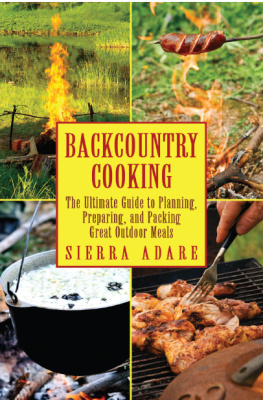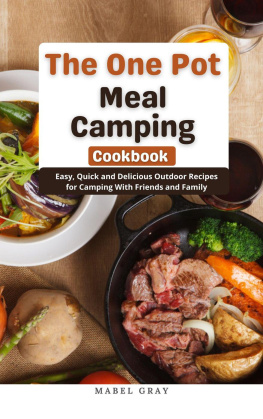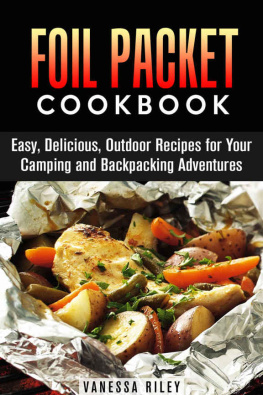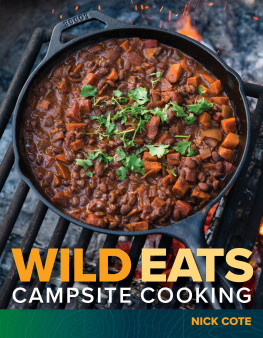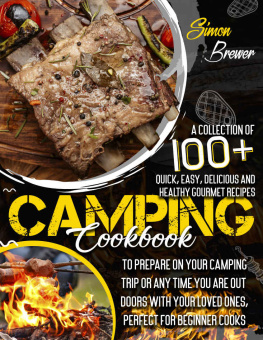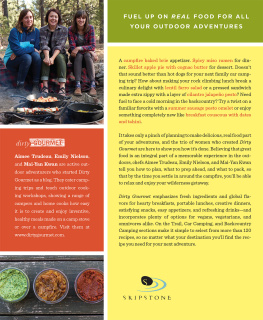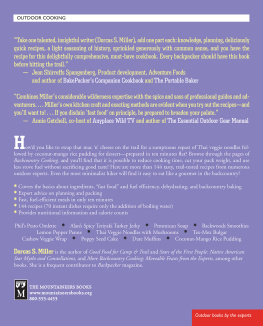All Rights Reserved. No part of this book may be reproduced in any manner without the express written consent of the publisher, except in the case of brief excerpts in critical reviews or articles. All inquiries should be addressed to Skyhorse Publishing, 307 West 36th Street, 11th Floor, New York, NY 10018.
Skyhorse Publishing books may be purchased in bulk at special discounts for sales promotion, corporate gifts, fund-raising, or educational purposes. Special editions can also be created to specifications. For details, contact the Special Sales Department, Skyhorse Publishing, 307 West 36th Street, 11th Floor, New York, NY 10018 or info@skyhorsepublishing.com.
Skyhorse and Skyhorse Publishing are registered trademarks of Skyhorse Publishing, Inc., a Delaware corporation.
Library of Congress Cataloging-in-Publication Data is available on file.
ISBN: 978-1-61608-312-0
INTRODUCTION
TO COOKING BACKCOUNTRY STYLE
After a long day of slogging through mud up to your gaiters, the last thing you want to think about when you stagger into camp is What am I going to fix for dinner?! Nonetheless, after such a day, everybody, including the cook, deserves a hearty, tasty meal thats easy to make. Hence this cookbook.
Cooking Backcountry Style features a system for preparing quick, homemade meals in the field. The secret stems from whole meal planning and packaging before the trip ever begins. You can find all the ingredients youll need at your local grocery store. And unlike expensive, dehydrated backcountry meals purchased from an outdoor store, the meals outlined in this cookbook cost no more than the average grocery bill to feed the same number of people for the same length of time.
If you plan to camp out on a regular basis, try shopping for your supplies and storage containers in bulk at warehouse outlets or online at camping and backpacking supply sites. Resupplying your containers from bulk supplies (flour, cornmeal, powdered milk, spices, beans, and such) will reduce your overall costs and maintain a ready resupply of ingredients for the next trip. Experimenting with dehydrating foods when they are in season will add to the variety and availability of your favorite foods when heading into the backcountry. Expanding your tastes with the inclusion of different types of seasonal food items will also increase your ability to provide proper nutritional needs while enjoying your trip.
HOW IT WORKS

In each of the sections, there are daily menus, a shopping list, and the preparations you need to do at home in advance of your trip, such as dehydrating foods for the meals. Then all you have to do is prep the foods for each days menu and bag them by the meal. Although car camping meals require less at-home prep, it is still a good idea to gather foods and bag by meals the items that will not be purchased along the way. For trips needing dehydrated foods, begin the process about a month before
the scheduled expedition to ensure plenty of time for dehydrating foods. Drying one meals worth of ingredients together makes packaging meals easy and convenient. When you tackle the wilderness, a field preparation timetable guides you through what to do upon reaching the nights campsite, which dish to get on the stove first, and how to maximize fuel use by double-decker cooking. The resultappetizing meals in a hurry. Tips on keeping foods hot, fast rehydration, and kitchen organization smoothen the flow from pack to plate, or bowl as the case may be. Usually within half an hour, starving, cranky backpackers, goat packers, horse packers, canoeists, or car campers become happy campers. Following every meal is my method for adapting the menu for each kind of trip.
A LOOK AT THE RECIPES

After you look over the recipes and realize they contain several ingredients you may not use at home, consider this: In the backcountry, your appetite will increase. How much depends on the exertion level, altitude, and weather conditions you face. People generally need one and one-half to two pounds of food every day in the wilderness. Winter campers require two to two and one-half pounds. If your crew eats with hearty appetites at home, you might want to do a test run. Try one or two of the menus at home (without dehydrating the ingredients first). Should every morsel disappear and the gang still wants more, increase the amounts in the recipes to accommodate. On the other hand, dont shortchange yourself by thinking youll never be able to consume half a pound of trail food in an afternoon or finish off a dessert in the evenings. Remember, youll be out there hauling around fifty to eighty pounds of gear, getting the most intense aerobic exercise possible climbing up and down hills or mountains, or paddling rivers. Horse packing provides a less strenuous workout (on you) than backpacking or goat packing, but guess who gets to lift those sixty-plus-pound panniers onto the sawbucks on top of a tall horse! Paddling all day burns calories, too. Car camping expends the least calories of the lot, and it is reflected in the smaller portions in this section. Therefore you might want to increase the amounts in these recipes should you want to substitute any of them for dishes or meals in the other sections.
While were at it, youll also notice salt sprinkled throughout the backcountry recipes. You may not use it at home (I dont); however, while backpacking and goat packing, in particular, your body needs more salt than normal. It helps your muscles work, and the harder you exert yourself, the more you lose salt through sweating. If your diet restricts the use of salt, feel free to omit it from the recipes. Nevertheless, check with your physician about carrying salt with you into the field just in case.
Margarine may not show up often on your table at home. I cook with butter or olive oil at home. Nonetheless, taking real butter into the field can be problematic as it can turn or melt and separate quickly, depending on the temperature. NOTE: If you usually use a nonstick cooking spray and dont mind hauling the extra weight, you can replace much of the margarine used in these recipes with the cooking spray. Unfortunately, at high altitudes where the temperature remains cold, the propellant can get a bit uncooperative. For winter camping in cold regions, I recommend taking margarine or butter. The fat content, in particular in butter, not only supplies energy you will need, it also takes longer to digest. This helps you feel satisfied at the end of the meal.

